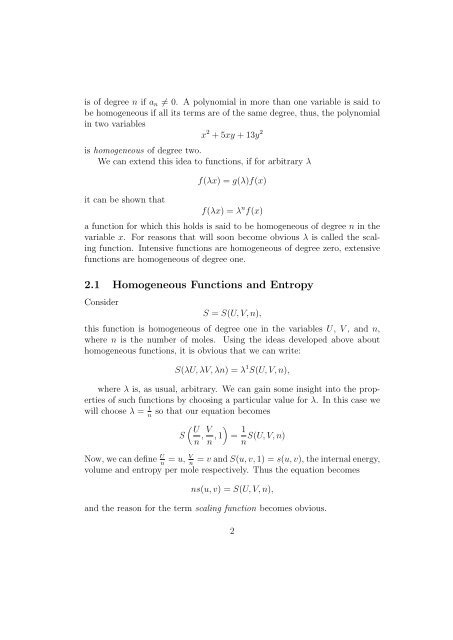The Euler Equation and the Gibbs-Duhem Equation - TUG
The Euler Equation and the Gibbs-Duhem Equation - TUG
The Euler Equation and the Gibbs-Duhem Equation - TUG
You also want an ePaper? Increase the reach of your titles
YUMPU automatically turns print PDFs into web optimized ePapers that Google loves.
is of degree n if a n ≠ 0. A polynomial in more than one variable is said to<br />
be homogeneous if all its terms are of <strong>the</strong> same degree, thus, <strong>the</strong> polynomial<br />
in two variables<br />
x 2 + 5xy + 13y 2<br />
is homogeneous of degree two.<br />
We can extend this idea to functions, if for arbitrary λ<br />
it can be shown that<br />
f(λx) = g(λ)f(x)<br />
f(λx) = λ n f(x)<br />
a function for which this holds is said to be homogeneous of degree n in <strong>the</strong><br />
variable x. For reasons that will soon become obvious λ is called <strong>the</strong> scaling<br />
function. Intensive functions are homogeneous of degree zero, extensive<br />
functions are homogeneous of degree one.<br />
2.1 Homogeneous Functions <strong>and</strong> Entropy<br />
Consider<br />
S = S(U, V, n),<br />
this function is homogeneous of degree one in <strong>the</strong> variables U, V , <strong>and</strong> n,<br />
where n is <strong>the</strong> number of moles. Using <strong>the</strong> ideas developed above about<br />
homogeneous functions, it is obvious that we can write:<br />
S(λU, λV, λn) = λ 1 S(U, V, n),<br />
where λ is, as usual, arbitrary. We can gain some insight into <strong>the</strong> properties<br />
of such functions by choosing a particular value for λ. In this case we<br />
will choose λ = 1 so that our equation becomes<br />
n<br />
( U<br />
S<br />
n , V )<br />
n , 1<br />
= 1 S(U, V, n)<br />
n<br />
Now, we can define U = u, V = v <strong>and</strong> S(u, v, 1) = s(u, v), <strong>the</strong> internal energy,<br />
n n<br />
volume <strong>and</strong> entropy per mole respectively. Thus <strong>the</strong> equation becomes<br />
ns(u, v) = S(U, V, n),<br />
<strong>and</strong> <strong>the</strong> reason for <strong>the</strong> term scaling function becomes obvious.<br />
2
















